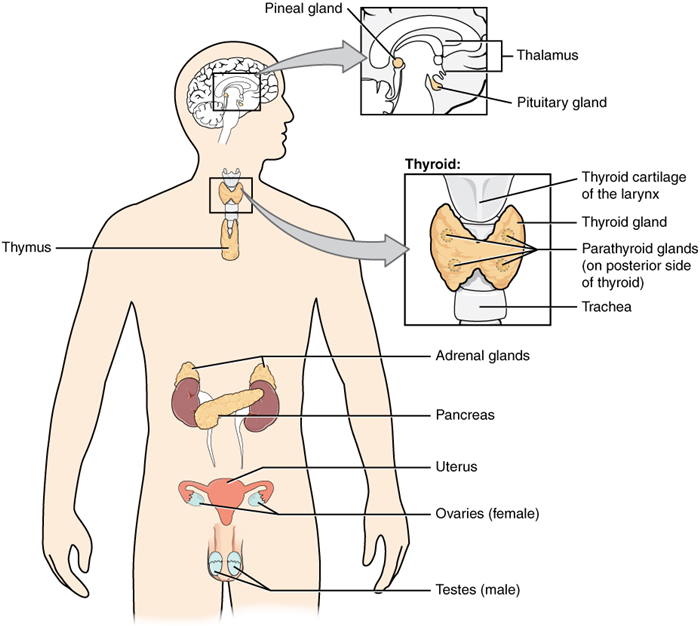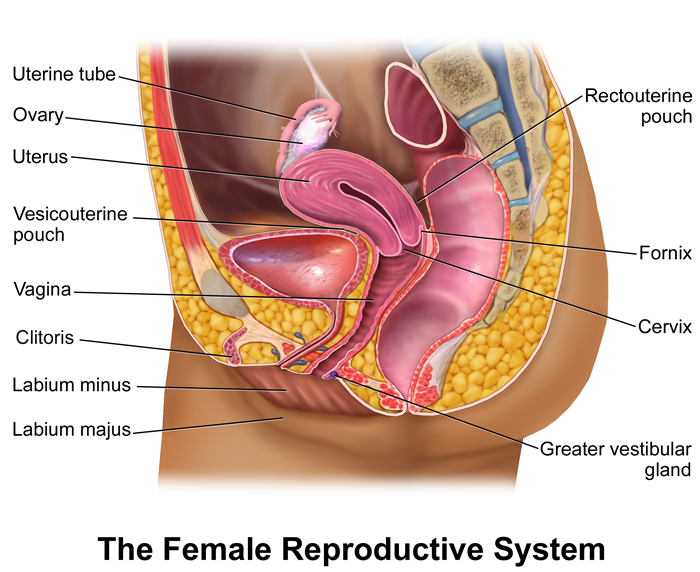Endocrine and Reproductive Systems
The endocrine system is similar to the nervous system, in that both systems send messages around the body. The endocrine system releases chemicals called hormones into the bloodstream. When these hormones reach target cells within the body, receptors on the target cells react, triggering a particular body response. For example, when you are feeling nervous, the hormone epinephrine is released into the bloodstream. When epinephrine reaches receptors on target cells, your heart rate increases, and your skeletal muscles become tense as part of the fight-or-flight response.
The speed at which hormones travel in the bloodstream is slow compared with the speed of nerve impulses. Thus, the endocrine system tends to regulate body processes that happen slowly over a long period of time. These processes include cell growth and development, metabolism, sexual function, and reproduction.
Glands are organs that produce and release substances. In the case of the endocrine system, these substances are hormones. Glands are found in the head and body, but not in the arms or legs. Different types of glands produce different types of hormones, and each hormone produces a unique effect.
Pituitary Gland
The pituitary gland is located in the brain and is connected to and controlled by the hypothalamus. The hypothalamus is an area of the brain that connects the nervous system to the endocrine system.
The pituitary gland secretes nine different hormones that either control other glands or directly regulate body processes. These hormones include adrenocorticotropic hormone (ACTH), which responds to stress and triggers the adrenal glands to release epinephrine; follicle-stimulating hormone (FSH), which triggers the production of sperm and the maturation of egg cells; and prolactin, which triggers the production of milk in females.

Other Glands
Other glands are located in the head or upper body, as shown in the diagram. The pineal gland secretes melatonin, which is involved in regulating body rhythms. The thyroid gland releases thyroxine, which regulates the process through which cells break down chemicals and produce energy. The parathyroid glands release hormones that help regulate the amount of calcium in the bloodstream. The thymus gland produces hormones that help the body fight disease.
Still other glands are located near the center of the body. The adrenal glands produce the hormone epinephrine, which causes the fight-or-flight response in your skeletal and heart muscles. The pancreas, which is also an organ of the digestive system, releases hormones called insulin and glucagon, which stimulate the liver to either take up or release sugar into the blood. Reproductive glands produce testosterone and estrogen hormones that control reproduction and the development of secondary sex characteristics.
The Reproductive System
The reproductive system is involved with sexual development and the production of offspring. Endocrine glands in the reproductive system produce sex hormones that are responsible for secondary sex characteristics in men and women. Sex hormones also contribute to the production of sex cells, or gametes. Female sex hormones regulate ovulation, the menstrual cycle, and pregnancy.
Testosterone and estrogen are the hormones mostly responsible for the physical differences between men and women. Testosterone is produced in male glands called testes and controls the development and function of the male reproductive system. It also controls male secondary sex characteristics, such as a deep voice and increased muscle mass. Estrogen is produced in female glands called ovaries and controls the development and function of the female reproductive system. It also controls female secondary sex characteristics, such as breast development.
Male Reproductive System
The male reproductive system includes, the testes, epididymis, scrotum, penis, urethra, and a variety of glands. The testes produce male gametes, called sperm and the hormone testosterone. Millions of sperm are produced each day and stored in the epididymis. The testes and epididymis are suspended in the scrotum, which is a sac that hangs outside the body. The position of the scrotum keeps sperm at a cooler temperature, so the sperm are able to mature. During sexual activity, the sperm travel toward the urethra, which is a tube that spans from the urinary bladder through the penis. A series of glands add fluids to the sperm to form semen. Semen leaves the body through the penis during ejaculation
Female Reproductive System
The female reproductive system includes the ovaries, fallopian tubes, uterus, and vagina. Female gametes, called eggs, are produced in the ovaries. The female reproduction system has several functions, including producing female sex hormones and storing and releasing the eggs.

The Menstrual Cycle
Every month, sexually mature women release an egg from one of their ovaries and shed their uterine lining. This process is referred to as the menstrual cycle. The cycle starts when an egg begins to mature inside a follicle in the ovary. The follicle produces estrogen, which causes the tissue that lines the uterus to thicken. In about 14 days, the egg is released from the follicle in a process called ovulation. The empty follicle continues to release estrogen and also begins to release another hormone, progesterone. These two hormones cause the uterine lining to grow even thicker. If the egg is not fertilized as it travels down the fallopian tube, it dies and disintegrates. The lining of the uterus breaks down and is shed through the vagina as menstrual blood. The cycle typically takes about 28 days and then begins again. If a mature egg and sperm unite, pregnancy results, and the menstrual cycle stops.
Fertilization
When an egg is fertilized by a sperm cell, it begins to divide. This ball of cells moves down the fallopian tube to the uterus and attaches itself to the uterine lining. Upon implantation, the ball of dividing cells is called an embryo. Some of the cells differentiate to form the placenta, which is an organ that allows nutrients and other materials to pass between the mother and the developing offspring. The embryo becomes a fetus eight weeks after fertilization. The fetus undergoes rapid development until about nine months into the pregnancy. At this point, the mother’s body produces hormones that cause labor. During labor, muscles in the uterus contract and relax, causing the baby to move down the birth canal until it is born.
Up Next
Homeostasis is responsible for keeping balance between all body systems and the environment. Learn how different body systems maintain body temperature, oxygen levels, and other values that are essential for our survival.
Related Sections
The skeletal, muscular, and nervous systems work together to help the body move. Learn about the structure and function of each of these body systems.
Digestive, Excretory, Respiratory, and Circulatory Systems
The respiratory, circulatory, digestive, and excretory systems deliver oxygen and nutrients and remove wastes. Learn how oxygen and nutrients are taken in and processed.
The endocrine system controls hormones that carry messages throughout the body. Learn how hormones regulate growth and development.
Homeostasis is responsible for keeping balance between all body systems and the environment. Learn how different body systems maintain body temperature, oxygen levels, and other values that are essential for our survival.
Nutrients provide hydration, energy, and structural elements that help our cells to function properly. Learn about six different nutrients the body needs for optimal health.
Harmful substances such as bacteria, viruses, and parasites can cause diseases in the body and disrupt the function of a body system. Learn how the body fights against disease and learn strategies for preventing disease.